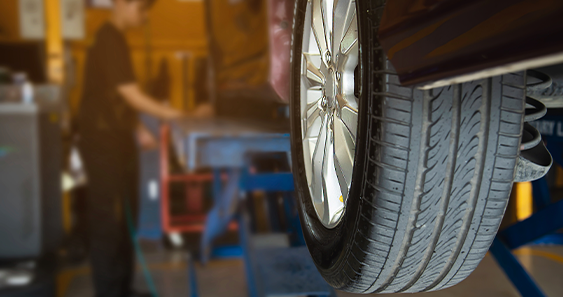Wheel alignment is important to ensure your car is safe to drive and handles as intended.
A lot of the time, people avoid getting an alignment done as they see it as surplus to requirement, and a time consuming process. We’re here to answer all your questions regarding alignment methods and length.
What is wheel alignment?
Wheel alignment is the process of adjusting the positioning and direction of a vehicle’s wheels so that they are all facing the same direction and are angled correctly. This is done by adjusting the suspension and steering system using specialist equipment to recalibrate the tie rods and control arms if necessary.
Wheel alignment is vital for both safety and comfort in your vehicle. A realignment will help your car to drive straight, with no drifting. It should also shorten your braking distance, reduce fuel consumption, and prevent fast tyre wear.
Learn more about how wheel alignment works in our dedicated blog post.
Will I need a 2 or 4 wheel alignment?
Choosing between a 2 or 4 wheel alignment depends on your vehicle:
- Two-wheel alignment – Often known as a front end alignment, this will usually consist of camber, toe and caster adjustments to your vehicles front end suspension and steering. Often recommended for vehicles with solid rear axles, such as trucks or heavy duty vehicles.
- Four-wheel alignment – A four-wheel alignment will include both front and rear suspension and steering adjustment. A professional will finely adjust your camber, toe and caster angles to restore perfect steering and handling. Often useful for passenger vehicles such as cars with four wheel drive.
It will also depend on other factors, such as the history of your vehicle, whether you’ve been in an accident previously, and the specifications of your car.
If you’re still unsure as to which type of alignment you need, not to worry! Our experts will be able to tell you whether your car needs a two-wheel or four-wheel alignment.
Factors affecting the length of a wheel alignment
Wheel alignments shouldn’t take too long, but many factors can impact the time taken. Try to understand these factors in relation to your vehicle so you know what to expect:
- Alignment requirements/complexity – An alignment might take longer if your vehicle is very old, or hasn’t been serviced for a while. This is because an older vehicle is likely to have more issues, or more severe issues. Your mechanic may even find broken parts which need replacing, which would also increase the length of the process. A two wheel alignment will also take less time than a four wheel.
- Custom modifications – If your vehicle has any suspension or steering systems which have been modified, the alignment is likely to take longer. This is because your mechanic will have to take extra care to ensure a safe and thorough alignment.
- Tyre conditions – Badly worn tyres can increase wheel alignment length by throwing off alignment readings. If this issue is bad enough, your mechanic may even recommend replacing tyres before they can proceed with the alignment.
- Wheel damage – Damaged wheels such as cracked, bent, or buckled alloys may also impact the alignment readings. For more minor damage, an alignment should still be possible and safe, but for more serious issues, you may have to get your alloys fixed or replaced before having an alignment done.
- Engineer quality – An excellent engineer, like ours here at Lancashire ADAS, is likely to provide a much quicker and reliable service. However, it’s important to note that a good and thorough alignment might mean fixing certain components to increase safety. Whilst we understand that you may be after a quick and easy service, we urge you to understand that our engineers put safety and quality first, and speed second.
- To recap, if your vehicle has any modifications, damaged tyres or wheels, or is old, your alignment is likely to take slightly longer than average.

Average time taken for a wheel alignment
Based on the above factors, your wheel alignment length might vary. However, you can expect that your alignment won’t take longer than an hour, and the average time is roughly 30 minutes.
Wheel alignment isn’t a lengthy process in general, but our professionals will ensure that everything is done safely and properly before finishing the process.
Can I speed up the wheel alignment process?
If you want to speed up the wheel alignment process, try to ensure that any damage or issues with your vehicle are resolved before booking an alignment. On top of this, make sure to communicate any body or suspension modifications to your engineer before they get started.

